Fujifilm FinePix HS10 Review
Fujifilm FinePix HS10
Fuji's new flagship super-zoom has 30x zoom and full HD video
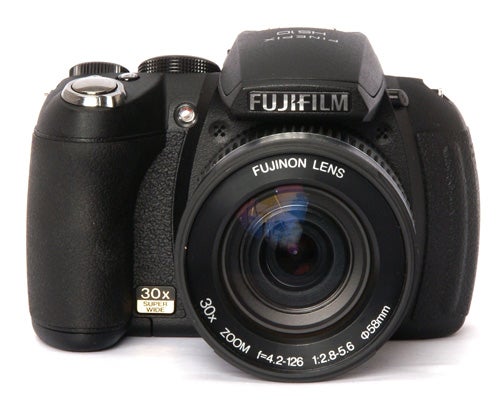
Verdict
Key Specifications
- Review Price: £399.00
The S200 EXR was always going to be a tough act to follow, so Fujifilm has pulled out all the stops and loaded the HS10 with every feature they could think of, including several new ones that are unique to this camera. Its basic specification is impressive to say the least. It has an amazingly powerful but very compact 30x zoom lens, the longest zoom range of any current camera, with a focal length range equivalent to 24-720mm, a maximum aperture of f/2.8-5.6 and manual zoom control. It has a 10.0-megapixel 1/2.3-inch back-illuminated CMOS sensor, a 3.0-inch 230k articulated monitor, a field-sequential 0.2-inch 200k resolution electronic viewfinder, and can shoot full 1080p HD video with stereo sound.
With most other manufacturers concentrating their development efforts on long-zoom compacts and new mirrorless system cameras the HS10 doesn’t have a lot of direct competition. The newly announced Panasonic FZ100 offers full HD video and a 24x zoom lens, but its closest competitor is the 18-month-old Canon PowerShot SX1 IS, which features full HD video, stereo audio and an articulated monitor, but only has a 20x zoom lens. It’s also about the same price. The Fuji HS10 is currently selling for around £399, but Fuji cameras tend to fall in price quite dramatically after a few months.
Like most of Fujifilm’s high-end super-zoom cameras the HS10 is physically quite large and heavy, measuring 130.6 x 90.7 x 126mm and weighing a hefty 730g including the four AA batteries that power it. This is comparable in size and weight to an APS-C digital SLR, and the camera has a very SLR-like shape, with a large comfortable rubber-coated handgrip and rear thumbgrip. The build quality of the plastic body is excellent, and the textured matt black finish looks good and provides a secure grip. Despite its size and weight the camera handles well, but it definitely one that you’ll need both hands to use.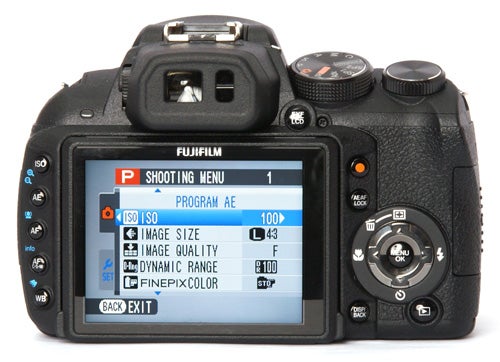
The control layout is very similar to that of a digital SLR. It has a large main mode dial and a smaller adjustment dial on the top panel, canted back by about 30 degrees to make them more accessible. It offers Program exposure, full auto, scene-recognition auto as well as aperture priority, shutter priority and full manual exposure, with a maximum shutter speed of 1/4000th of a second. Also on the top panel are dedicated buttons for exposure compensation and drive mode.
The rear controls are divided into two sections, with a row of buttons to the left of the monitor, each controlling a single function in both record and playback modes. On the right is a conventional D-pad, as well as buttons for AE/AF lock, display mode and playback. There is also a dedicated button to start video recording. The controls are well mounted and operate smoothly, but the method with the left-hand buttons, of press-the-button, turn-the-dial takes a little getting used to.
The monitor is mounted on an articulated arm and folds out by 45 degrees downwards and 90 degrees upwards, or anything in between, making it ideal for holding the camera over your head, or using as a waist-level finder. The screen itself is clear and bright, but it is quite prone to reflections and has a rather limited viewing angle. Obviously with the articulation this isn’t a major problem, and it is usually possible to tilt the screen so that glare isn’t a serious problem either.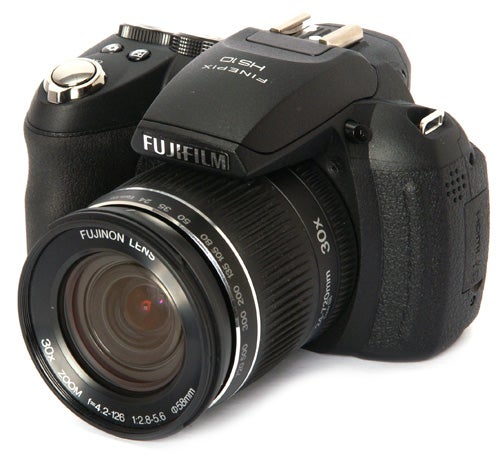
The electronic viewfinder uses what appears to be a field-sequential display with resolution of 200k dots. I usually like field sequential type viewfinders because they provide a sharper, smoother image than conventional mosaic LCDs, but the one in the HS10 has a relatively low refresh rate, with the result that every time you move your eye or pan the camera you get multi-coloured acid-flashback after images around any highlights, and also around the focusing target point. The viewfinder is sharp and bright enough for general use, but in manual focus mode it uses digital magnification to enlarge the centre of the image. This causes the image to pixilate badly, making it impossible to tell if it is in focus or not. The HS10 has a proximity sensor next to the eyepiece, and switches to viewfinder mode automatically when the camera is raised to the eye. However there is a delay of about two seconds, just long enough to be annoying.
The main feature of the HS10 is of course its remarkable lens. Its focal length range equivalent to 24-720mm is bigger than anything else on the market, however it is amazingly compact. At its minimum size it protrudes less than 7.5cm from the front of the camera, telescoping out to 12.5cm at maximum zoom. It has a graduated scale printed along the top of the barrel showing both the actual and 35mm-equivalent focal lengths. The zoom action is manual, operated by twisting the barrel like an SLR lens, and it also has a manual focus ring, although this is an electromechanical linkage. Fujifilm has expressed no interest in making a mirrorless system camera (so far, anyway), but when it can offer this sort of versatility in a single lens, covering everything from wide angle to extreme telephoto, there’s really no advantage to a removable lens.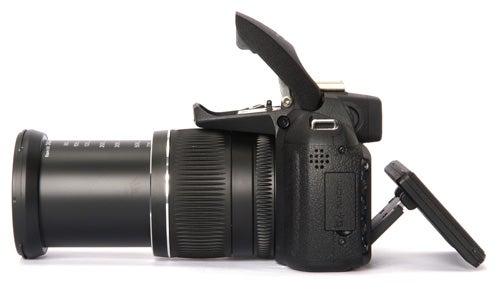
Fortunately the massive zoom range is accompanied by a very effective mechanical sensor-shift image stabilisation combined with digital stabilisation, and even at maximum zoom it can capture shake-free hand-held still images at shutter speeds as low as 1/40th of a second, an advantage of over four stops. However in video mode it is limited to digital stabilisation only, and it is impossible to capture steady video shots at full zoom without a tripod.
The video recording mode is excellent, capturing very sharp and detailed shots at 1920 x 1080 pixel resolution and 30fps, with excellent colour and exposure. The continuous autofocus in video mode is quick and effective, and manages to keep shots in focus even when zooming in and out. The manual zoom provides plenty of versatility and obviously doesn’t affect the soundtrack, but it does make it difficult to avoid camera shake, especially at longer focal lengths. Sound is recorded in stereo via two microphones mounted either side of the lens barrel, sheltered from the wind by the overhanging flash turret. The sound quality is very good and quite directional. The only thing lacking is the option to plug in an external microphone. Video is recorded in QuickTime MOV format, and maximum recording time is 29 minutes.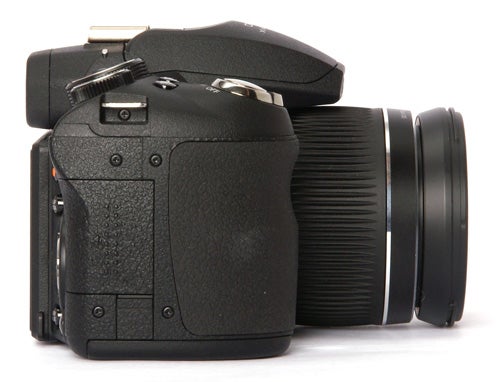
The HS10 also has a high speed video mode, capable of recording at 60, 120, 240, 480 or 1000fps, although at reduced resolution, with the fastest speed at only 224 x 64. This can produce some fascinating slow-motion effects, but the faster settings require very good light to produce any sort of acceptable quality.
Other high-tech features include a Motion Panorama mode shamelessly copied from the sweep panorama feature of Sony’s latest compact cameras. Even more interesting is the Motion Remover feature, which takes a sequence of shots, then combines them into one image but removes anything that has moved between frames, useful for removing distracting crowds of tourists from your holiday snaps, but only recording at two megapixel resolution. Multi-motion Capture records a sequence of five exposures in a single frame, also at 2MP size, while the Pro Low-light mode takes a sequence of four high-sensitivity low light shots and then combines them into a singe image with reduced noise. The HS10 also has face detection, tracking AF and a zoom-bracketing feature that uses digital zoom to take a sequence of three shots at different magnifications.
The HS in the HS10’s name stands for High Speed, so you’d expect the camera’s overall performance to be pretty impressive, however the 4.2 seconds that it takes to start up and take the first shot is very slow even for a big super-zoom. In single shot mode it has a shot-to-shot time of approximately 2.2 seconds, which is barely above average, however in continuous shooting mode it can shoot a burst of seven full-resolution shots at 10fps, or six shots in Raw mode.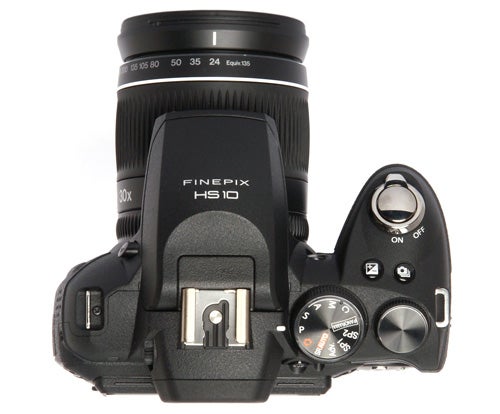
The autofocus system is accurate and reliable, and operates well in low light, even in very low light thanks to a good AF assist lamp, but it’s not particularly fast, taking nearly a second to focus even in good light. It takes the same time regardless of the zoom setting though. I’ve no doubt that the camera’s overall performance is mostly limited by the speed of the AF system.
The lens is not only extremely powerful, it is also of surprisingly high quality. The edge-to-edge sharpness is much better than I expected, given the slightly lacklustre performance of some previous Fuji optics, and it produces none of the chromatic aberration that has plagued previous Fuji super-zoom cameras. Barrel distortion at wide angle is automatically digitally corrected, but without the corner blurring that this process usually produces. The level of recorded detail is very good, and the relatively low compression preserves most of it. Shooting in Raw mode produces even better results.
One of the claimed advantages of back-illuminated sensors is improved dynamic range, but to be honest I couldn’t see much sign of this with the HS10. Dynamic range isn’t bad, and is especially good at preserving highlight detail, but shadow detail is still lacking unless the dynamic range booster option is used, only available at ISO settings of 400 or higher. Colour reproduction is always a Fuji strong point though, and the HS10 produces superb results, with rich saturated tones, smooth colour gradients and plenty of detail.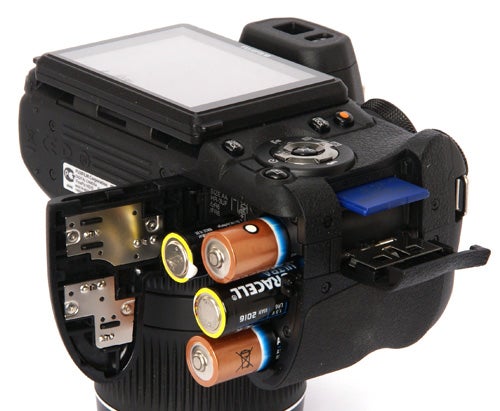
Improved noise reduction is also a supposed benefit of a back-illuminated sensor, but again it’s hard to see any advantage. The HS10 produces very good image quality at up to 400 ISO, but after that the quality drops off quickly, losing a lot of fine detail at 800 ISO and colour saturation starting to fade from 1600. The maximum 6400 ISO produces very poor results.
”’Verdict”’
The Fujifilm FinePix HS10 is a technological tour-de-force, cramming as many features as possible into one camera. It is well made, pleasant to handle and offers the kind of versatility usually only possible with a DSLR kit. Many of its features are useful, but some are mere novelties. The lens is of good quality, but the slow autofocus and barely-above-average image quality make the high price off-putting.
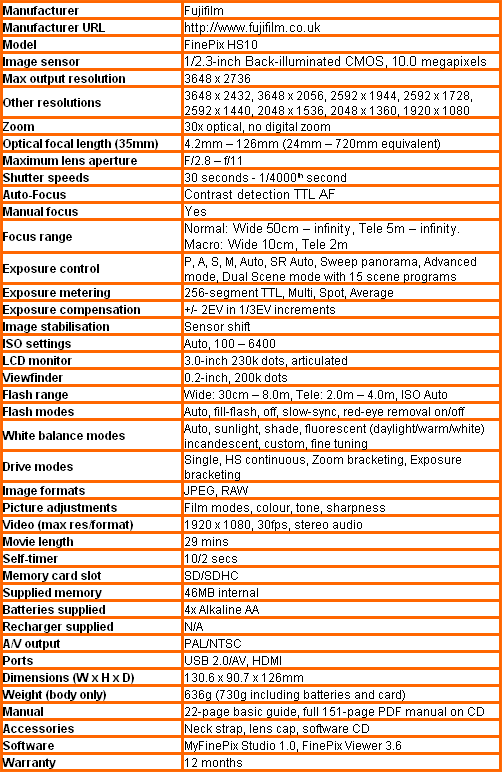
”Over the next few pages we show a range of test shots. On this page the full size image at the minimum and maximum ISO settings have been reduced to let you see the full image, and a series of full resolution crops have taken from original images at a range of ISO settings to show the overall image quality. These pictures were taken indoors using shaded natural light. ”
—-
This is the full frame at minimum ISO.
—-
Picture quality is very good at 100 ISO.
—-
Almost identical results at 200 ISO.
—-
Still no problems at 400 ISO.
—-
The noise reduction cuts in at 800 ISO, losing some fine detail.
—-
Noise is becoming a problem at 1600 ISO.
—-
Even worse at 3200 ISO, with little fine detail left.
—-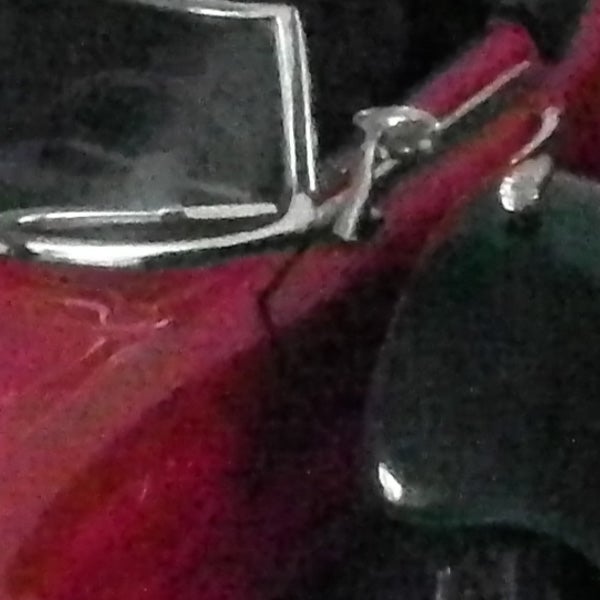
Image quality at the maximum 6400 ISO is very poor.
—-
This is the full frame at maximum ISO.
—-
”A range of general test shots are shown over the next two pages. In some cases, the full size image has been reduced for bandwidth purposes, and a crop taken from the original full resolution image has been placed below it to show the overall image quality. Some other pictures may be clicked to view the original full-size image. ”
—-
Here’s the usual detail test shot of the West Window of Exeter Cathedral, for you to compare with other cameras. See below for a full res crop, or click to see the whole picture. File size 4.1MB.
—-
The level of fine detail is impressive for a 10MP camera.
—-
The huge lens produces no barrel distortion at wide angle.
—-
Centre sharpness is pretty good.
—-
Corner sharpness is also very good, with none of Fuji’s usual chromatic aberration.
—-
”Here are some general test shots to help evaluate the camera’s overall image quality, including dynamic range, colour rendition and the zoom range of the lens. Some pictures may be clicked to download the full size original image.”
—-
The wide angle is equivalent to 24mm.
—-
The telephoto end is equivalent to a massive 720mm.
—-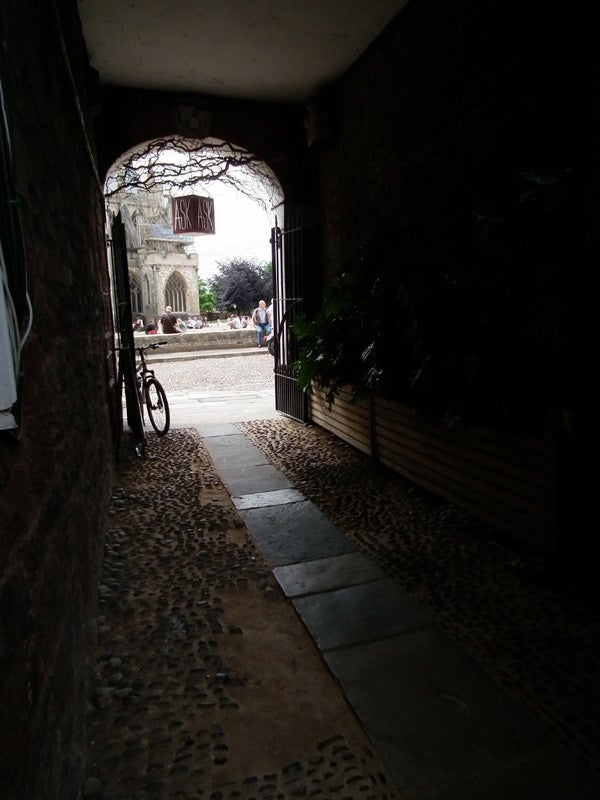
In standard mode the dynamic range isn’t brilliant, although it retains good highlight detail.
—-
The Dynamic Range booster helps capture more shadow detail.
—-
Colour rendition is one of Fuji’s real strengths.
—-![]()
The Motion Panorama mode is much the same as Sony’s Sweep Panorama.
—-
Trusted Score
Score in detail
-
Value 7
-
Image Quality 7
-
Build Quality 8
Features
| Camera type | Super Zoom |
| Megapixels (Megapixel) | 10.3 Megapixel |
| Optical Zoom (Times) | 30x |
| Image Sensor | 1/2.3-inch back-illuminated CMOS |
| Optical focal length | 4.2mm to 126mm |
| Shutter speed | 30 seconds to 1/4000th sec |
| Auto focus | Contrast detection TTL AF |
| Manual focus | Yes |
| Max output resolution | 3648x2736 |
| Other resolutions | 3648x2432, 3648x2056, 2592x1944, 2592x1728, 2592x1449, 2048x1536, 2048x1360, 1920x1080 |
| Focus range | Wide 50cm to infinity, Tele 5m to infinity. Macro: Wide 10cm, Tele 2m |
| Exposure control | P, A, S, M, Auto, SR Auto, Sweep panorama, Advanced mode, Dual Scene mode with 15 scene programs |
| Exposure metering | 256-segment TTL, Multi, Spot, Average |
| Exposure compensation | +/-2EV in 1.3 EV increments |
| Image Stabilisation | Sensor shift |
| ISO settings | Auto, 100 - 6400 |
| LCD Monitor | 3.0-inch 230k dots |
| Viewfinder | 0.2-inch, 200k dots |
| Flash range | Wide: 30cm - 8m, Tele: 2m - 4m, ISO Auto |
| Flash modes | Auto, fill-flash, off, slow sync, red-eye removal on/off |
| White balance modes | Auto, sunlight, shade, fluorescent 1/2/3 |
| Drive modes | Single, HS continuous, Zoom bracketing, Exposure bracketing |
| Image formats | JPEG, RAW |
| Picture adjustments | Film modes, colour, tone, sharpness |
| Video (max res/format) | 1920x1080 at 30fps |
| Movie length | 29 mins |
| Self timer | 10/2 secs |
| Memory card slot | SD/SDHC |
| Supplied memory | 46MB internal |
| Batteries supplied | 4x Alkaline AA |
| Charger supplied | N/A |
| A/V output | PAL/NTSC |
| Charging/Computer Connection | USB 2.0 |
| HDMI | Yes |
| AV Out | Yes |
| Manual | 27-page printed basic manual, full 151-page PDF manual on CD |
Physical Specifications
| Dimensions Width (Millimeter) | 130.6mm |
| Depth (Millimeter) | 90.7mm |
| Weight (body only) (Kilogram) | 636g (730g including batteries and card)kg |

